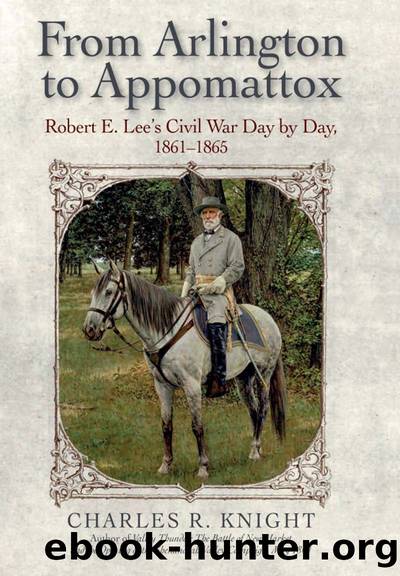From Arlington to Appomattox by Charles R. Knight

Author:Charles R. Knight [Knight, Charles R.]
Language: eng
Format: epub
Tags: History, United States, Civil War Period (1850-1877), State & Local, South (AL; AR; FL; GA; KY; LA; MS; NC; SC; TN; VA; WV), Modern, 19th Century
ISBN: 9781611215021
Google: sgpVzQEACAAJ
Publisher: Savas Beatie
Published: 2021-06-04T22:11:16+00:00
June 1863
There was little time for General Leeâs new commanders to become acquainted with their corps, subordinates, and responsibilities before the Army of Northern Virginia embarked on another offensive aimed once more at Pennsylvania. Lee departed Fredericksburg for Culpeper before the first week of June was over. Even as he rode toward the Blue Ridge, he reminded the War Department in Richmond that he needed every available soldier with his army, and pressed for the creation of a new command under Gen. P. G. T. Beauregard to threaten Washington from north-central Virginia while his own army operated north of the Potomac River.1
For all Leeâs planning and wrangling with the politicians in Richmond, his offensive almost ended before began it began when Union cavalry surprised Jeb Stuart around Culpeper. Stuart staged two reviews of his horsemen in a matter of days at Brandy Station, with Lee attending the second review on the 8th. The gallant pageantry exhausted Stuartâs troopers and horses and nearly led to disaster when Union horsemen crossed the Rappahannock River on the morning of June 9 and caught Stuart unawares. Lee and several of his generals were briefly isolated in a house watching the fighting before Rooneyâs cavalry came to their rescue.2 Soon thereafter Rooney fell wounded and was sent to Hickory Hill to recuperate.3 The fighting swirled for hours and although Stuart managed to recover in time to prevent the Federals from discovering Leeâs movement toward the Shenandoah Valley, the Battle of Brandy Station was a watershed moment for the Union mounted arm. âThe Northern horsemen,â concluded noted cavalry historian Eric Wittenberg, âwere finally the equals of their Southern counterparts, and they would never look back.â4
Despite the near-disaster Lee concluded the Federals had not discovered his intentions and continued his planned campaign north. Stonewall Jacksonâs former corps, now under Richard S. Ewell, led the way into the Valley, where Ewellâin Jackson-like fashionâscored a major victory at Winchester to clear the way to and across the Potomac. It looked as though Ewell had learned well under his former teacher. Lee needed someone he could trust to operate independently, as Jackson had, and the choice to have Ewell lead the Second Corps appeared to be a good one. Lee, meanwhile, remained farther back with the corps of Longstreet and A. P. Hill.
On either June 19 or 21, Stuart met personally with Lee and submitted a plan to have his cavalry cross the Potomac behind (east of) Hookerâs army and ride into Maryland to cut Hookerâs communications with Washington and Baltimore and create as much havoc as possible. Lee sanctioned the move with a few stipulations. Lee paused in the lower (northern) Shenandoah for a time at Berryville, where he issued strict orders concerning the behavior of his troops in enemy territory. He expected them to behave responsibly and to pay for anything taken from civilians.5
Also while at Berryville, Lee and his aide Charles Venable appear to have gotten into some sort of disagreement that induced Maj. Venable to considering
Download
This site does not store any files on its server. We only index and link to content provided by other sites. Please contact the content providers to delete copyright contents if any and email us, we'll remove relevant links or contents immediately.
In Cold Blood by Truman Capote(3311)
The Innovators: How a Group of Hackers, Geniuses, and Geeks Created the Digital Revolution by Walter Isaacson(2845)
Steve Jobs by Walter Isaacson(2836)
All the President's Men by Carl Bernstein & Bob Woodward(2328)
Lonely Planet New York City by Lonely Planet(2172)
And the Band Played On by Randy Shilts(2130)
The Room Where It Happened by John Bolton;(2104)
The Poisoner's Handbook by Deborah Blum(2093)
The Murder of Marilyn Monroe by Jay Margolis(2059)
The Innovators by Walter Isaacson(2056)
Lincoln by David Herbert Donald(1945)
A Colony in a Nation by Chris Hayes(1881)
Under the Banner of Heaven: A Story of Violent Faith by Jon Krakauer(1750)
Amelia Earhart by Doris L. Rich(1650)
The Unsettlers by Mark Sundeen(1647)
Being George Washington by Beck Glenn(1622)
Birdmen by Lawrence Goldstone(1621)
Dirt by Bill Buford(1612)
Zeitoun by Dave Eggers(1593)
